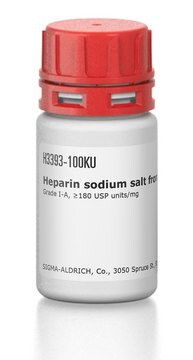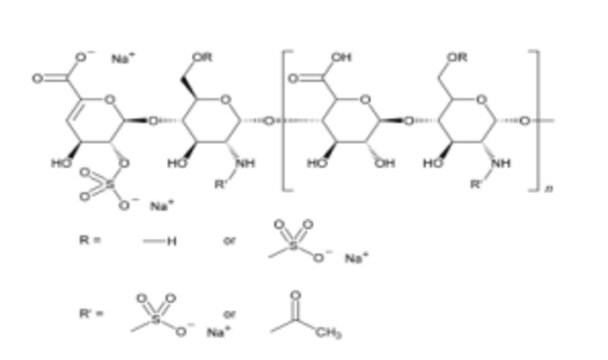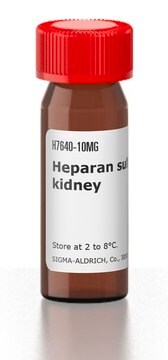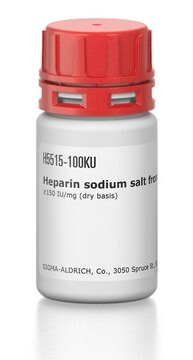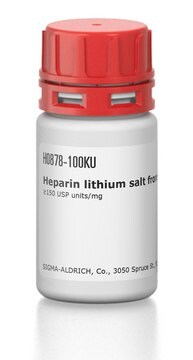H3149
Heparin sodium salt from porcine intestinal mucosa
Grade I-A, ≥180 USP units/mg, powder, BioReagent, suitable for cell culture
Recommended Products
biological source
Porcine intestinal mucosa
Quality Level
type
Grade I-A
product line
BioReagent
form
powder
specific activity
≥180 USP units/mg
technique(s)
cell culture | mammalian: suitable
color
beige
solubility
H2O: 50 mg/mL
Looking for similar products? Visit Product Comparison Guide
Related Categories
General description
Application
- Heparin sodium salt from porcine intestinal mucosa has been used in sLRP (soluble circulating low density lipoprotein receptor-related protein-1) purification from human plasma.
- It has been used as a supplement in M199 medium for culturing of human umbilical vein endothelial cells.
- It has been used as an anticoagulant agent during isolation of blood.
Storage Class Code
11 - Combustible Solids
WGK
WGK 2
Flash Point(F)
Not applicable
Flash Point(C)
Not applicable
Personal Protective Equipment
Regulatory Information
Certificates of Analysis (COA)
Search for Certificates of Analysis (COA) by entering the products Lot/Batch Number. Lot and Batch Numbers can be found on a product’s label following the words ‘Lot’ or ‘Batch’.
Already Own This Product?
Documents related to the products that you have purchased in the past have been gathered in the Document Library for your convenience.
Difficulty Finding Your Product Or Lot/Batch Number?
How to Find the Product Number
Product numbers are combined with Pack Sizes/Quantity when displayed on the website (example: T1503-25G). Please make sure you enter ONLY the product number in the Product Number field (example: T1503).
Example:
Additional examples:
705578-5MG-PW
PL860-CGA/SHF-1EA
MMYOMAG-74K-13
1000309185
enter as 1.000309185)
Having trouble? Feel free to contact Technical Service for assistance.
How to Find a Lot/Batch Number for COA
Lot and Batch Numbers can be found on a product's label following the words 'Lot' or 'Batch'.
Aldrich Products
For a lot number such as TO09019TO, enter it as 09019TO (without the first two letters 'TO').
For a lot number with a filling-code such as 05427ES-021, enter it as 05427ES (without the filling-code '-021').
For a lot number with a filling-code such as STBB0728K9, enter it as STBB0728 without the filling-code 'K9'.
Not Finding What You Are Looking For?
In some cases, a COA may not be available online. If your search was unable to find the COA you can request one.
How is Heparin sodium salt from porcine intestinal mucosa, Product H3149, solubilized?
Heparin sodium salt from porcine intestinal mucosa is soluble in deionized water at a concentrationi of 50 mg/mL.
How much of Heparin sodium salt from porcine intestinal mucosa, Product H3149, is used for cell culture?
Solutions at 0.5 mg per mL were tested in cell culture. Start at this concentration, and titer from there to determine the optimal concentration for usage.
How are solutions Heparin sodium salt from porcine intestinal mucosa, Product H3149, stored?
Solutions can be stored at 2-8C for up to 2 years, if sterile filtered through a 0.22 micron filter. Benzyl alcohol (0.06-1%) can be added to solutions to prevent microbial growth.
How many milligrams of Heparin sodium salt, Product H3149, are in the bottle?
The potency, in units/mg, is lot-specific; the value can be found on the certificate of analysis. It is typically over 140 units per mg. The number of milligrams can be calculated by dividing the number of units by the potency in units per mg.
What is the molecular weight of Heparin sodium salt?
Heparin is a mixture of polyanion chains having molecular weights ranging from 6,000 to 30,000 Daltons, with most chains in the range of 17,000 to 19,000 Daltons.
How much Heparin sodium salt, is used to prevent coagulation?
We suggest using 20 to 50 units per mL of blood.
What is the best way to sterilize Heparin sodium salt?
Although solutions may be autoclaved at 121 °C for 5 to 10 minutes, we generally recommend sterile filtration. This is because prolonged autoclaving may have an effect on its activity.
What concentration of Heparin sodium salt, can I use to inhibit RNAse activity?
Heparin has been used at concentrations ranging from 100 to 500 μg/mL. This has been reported in the J. Biol. Chem., 248, 2095 (1973).
Which document(s) contains shelf-life or expiration date information for a given product?
If available for a given product, the recommended re-test date or the expiration date can be found on the Certificate of Analysis.
How do I get lot-specific information or a Certificate of Analysis?
The lot specific COA document can be found by entering the lot number above under the "Documents" section.
How do I find price and availability?
There are several ways to find pricing and availability for our products. Once you log onto our website, you will find the price and availability displayed on the product detail page. You can contact any of our Customer Sales and Service offices to receive a quote. USA customers: 1-800-325-3010 or view local office numbers.
What is the Department of Transportation shipping information for this product?
Transportation information can be found in Section 14 of the product's (M)SDS.To access the shipping information for this material, use the link on the product detail page for the product.
My question is not addressed here, how can I contact Technical Service for assistance?
Ask a Scientist here.
Our team of scientists has experience in all areas of research including Life Science, Material Science, Chemical Synthesis, Chromatography, Analytical and many others.
Contact Technical Service